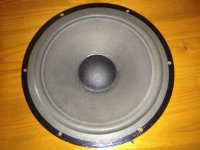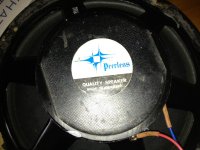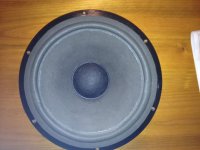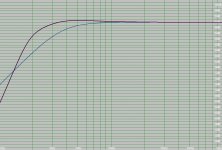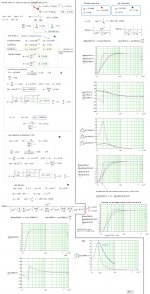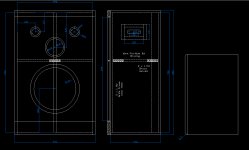Hello there, I am just wondering what these speakers are all about. I got them off an auction site today but I reckon they are from the 70's and may not have any pdf, graphs or data available. I am just hoping someone may recognize them. I will try to upload the pictures so you can have a look.
The bloke that sold them said they have been re-cushed in the past and that they were in 100lt boxes. the same fella was selling a 3-way Xover that I guessed may have come from the same enclosure.
The original speaker manufacturer is unknown to me but the Xover the chap was selling is a very basic 2nd order job with intersections at 700Hz and 5kHz. - see the piccie
The bloke that sold them said they have been re-cushed in the past and that they were in 100lt boxes. the same fella was selling a 3-way Xover that I guessed may have come from the same enclosure.
The original speaker manufacturer is unknown to me but the Xover the chap was selling is a very basic 2nd order job with intersections at 700Hz and 5kHz. - see the piccie
Attachments
Peerless KD120WFX Update
UPDATE
OK, I have roughly determined the t&s small signal values and they are; Vas 62lt, Qms 3.71, Qes 0.61, Qts 0.52, spl 94dbA and fs 27 Hz
These results a back-yard estimates and not entirely accurate but they give me a good starting point. The fs figure is wrong because they resonate at ~ 25Hz, but the calculations told me that it was 27Hz.
Question? Take a look at the two plots added in the picture below, the volume of the boxes I want to use is 84lt or say 80lt for a vented enclosure. Consider the age of the speaker (33years but reconed say 10 years ago). Look at the ported model which has the higher spl down low in the 10 - 30Hz region. Now, can you tell me if this will over-extend the speakers suspension and damage the voice coil former with the dire implications of such a stress?
For your Reference I now know that the speakers were part of a kit marketed in australia back in the eighties, the 'PAS100' and as the name implies the bins were 100lt. They were a sealed type of box.
UPDATE
OK, I have roughly determined the t&s small signal values and they are; Vas 62lt, Qms 3.71, Qes 0.61, Qts 0.52, spl 94dbA and fs 27 Hz
These results a back-yard estimates and not entirely accurate but they give me a good starting point. The fs figure is wrong because they resonate at ~ 25Hz, but the calculations told me that it was 27Hz.
Question? Take a look at the two plots added in the picture below, the volume of the boxes I want to use is 84lt or say 80lt for a vented enclosure. Consider the age of the speaker (33years but reconed say 10 years ago). Look at the ported model which has the higher spl down low in the 10 - 30Hz region. Now, can you tell me if this will over-extend the speakers suspension and damage the voice coil former with the dire implications of such a stress?
For your Reference I now know that the speakers were part of a kit marketed in australia back in the eighties, the 'PAS100' and as the name implies the bins were 100lt. They were a sealed type of box.
Attachments
..Question?.. spl down low in the 10 - 30Hz region. Now, can you tell me if this will over-extend the speakers suspension and damage the voice coil former with the dire implications of such a stress?..
Hi,
Its impossible to answer your Q. as you haven't provided any Coil related info= insufficient data...only a few 'Rookie' parameters. Nothing much can be said... I leave to others to write about wishful thinkings ...See my picture:
Attachments
Attitude
To the previous poster. Are you the guy that wore the tight pants in Abba?
When I was a young lad, my mother told me no-one is infallible & nothing impossible - Good advice for all of us I think.
I find the word "Rookie" offensive when it is used in this context.
I'll put it down to a translation error, unless you tell me I am a rookie again! Bjorn.
To the previous poster. Are you the guy that wore the tight pants in Abba?
When I was a young lad, my mother told me no-one is infallible & nothing impossible - Good advice for all of us I think.
I find the word "Rookie" offensive when it is used in this context.
I'll put it down to a translation error, unless you tell me I am a rookie again! Bjorn.
Sealed v Ported relationship to diaphragm travel @ given freq.
To avoid any further confusion I will rephrase my question so that some helpful members can assist me by using their personal observations of cone/voice coil travel and how it generally relates to questions A & B below.
I am looking for actual observations rather than rhetoric. But I will not criticize any comments unless they are of a personal nature.
A. Sealed v Ported boxes of a given size. A rough idea of how much extra travel is experienced in one or the other. Or do both enclosures give similar extension?
B. If I were to manipulate the porting in any given box to shift the resonance to a lower frequency level, does the the cone and voice coil generally move further to accomplish this? further than is neccessary to accomplish the actual frequency I mean? AND Does this phenomenon have a certain relationsip in regard to frequency. Is this a linear characteristic or perhaps exponential? I aknowledge that the diaphragm moves more at lf and less at hf but does the whole damn loco' run away if I try to squeeze to much from the boiler?
I am a joiner by trade and a back yard speaker builder on the weekends. I am not a rocket scientist so please keep it simple, but I do love using maths and careful observation to solve everyday issues.
To avoid any further confusion I will rephrase my question so that some helpful members can assist me by using their personal observations of cone/voice coil travel and how it generally relates to questions A & B below.
I am looking for actual observations rather than rhetoric. But I will not criticize any comments unless they are of a personal nature.
A. Sealed v Ported boxes of a given size. A rough idea of how much extra travel is experienced in one or the other. Or do both enclosures give similar extension?
B. If I were to manipulate the porting in any given box to shift the resonance to a lower frequency level, does the the cone and voice coil generally move further to accomplish this? further than is neccessary to accomplish the actual frequency I mean? AND Does this phenomenon have a certain relationsip in regard to frequency. Is this a linear characteristic or perhaps exponential? I aknowledge that the diaphragm moves more at lf and less at hf but does the whole damn loco' run away if I try to squeeze to much from the boiler?
I am a joiner by trade and a back yard speaker builder on the weekends. I am not a rocket scientist so please keep it simple, but I do love using maths and careful observation to solve everyday issues.
A
Travel is usually what we would refer to as X-max/X-damage the distance the cone moves
Extension is usually how we refer to the depth of bass. So a ported box will ( generally and a beginners answer) give better extension with less travel UNTIL the driver unloads and then the Voice Coil goes too far and the driver dies
If the original box design was a sealed box I would stay with that. Before anybody can comment on the cross-over you bought as part of the deal we would need to know more about the drivers you intend to use for the midrange and tweeter.
Those frequencies sound more suitable for closed back drivers typical of the late 70s
The lower the frequency the greater the distance the cone will move and I doubt that a driver from that era will give you much below 40 or 50 Hz when mounted in a sealed box. Driver travel is a combination of factors, including box size and power applied.
Far too many variables to give any more than general approximations
Yep, try and squeeze too much from it and the boiler in the loco blows up
Travel is usually what we would refer to as X-max/X-damage the distance the cone moves
Extension is usually how we refer to the depth of bass. So a ported box will ( generally and a beginners answer) give better extension with less travel UNTIL the driver unloads and then the Voice Coil goes too far and the driver dies
If the original box design was a sealed box I would stay with that. Before anybody can comment on the cross-over you bought as part of the deal we would need to know more about the drivers you intend to use for the midrange and tweeter.
Those frequencies sound more suitable for closed back drivers typical of the late 70s
The lower the frequency the greater the distance the cone will move and I doubt that a driver from that era will give you much below 40 or 50 Hz when mounted in a sealed box. Driver travel is a combination of factors, including box size and power applied.
Far too many variables to give any more than general approximations
Yep, try and squeeze too much from it and the boiler in the loco blows up
The magnet has a flux density of 11,800 gauss and my home made meter measures 560uH at 2.4kHz and 660 at 240Hz, if this is a help.
I put your figures into my box program and I am surprised but they will deliver really good bass in a 100 litre box, but assuming an X-max of 4mm they will handle about 15 watts to give you that 97dB and an F6 / F10 of ~26 and 20 Hz
Using a smaller box of 50 liters you would not loose much in the way of extension and you would be less likely to damage the driver by over driving, it they were mine I'd use a 50 liter box heavily stuff with fiberglass
Using your figures a ported box will be huge at 180 liters and have problems below 40Hz
Using a smaller box of 50 liters you would not loose much in the way of extension and you would be less likely to damage the driver by over driving, it they were mine I'd use a 50 liter box heavily stuff with fiberglass
Using your figures a ported box will be huge at 180 liters and have problems below 40Hz
I concur with the graphs posted by Bjorno, DCR VC diameter, X-max or the magnet gap and plate thickness are all needed to give approximations of power handling and SPLs. I used 4mm as my experience says that is a safe approximation and typical of woofers of that decade
It would be far better to relate how the T&S parameters were obtained and if they then can be verified as true for that particular model,then it would be easier to offer advise with confidence. The specs as stated,suggest a sealed box is your most likely candidate
Resolution - Sealed Box
Hi there Moondog, foggy weather down here for the last few days and the rain has been welcome.
Mate, I think you are right, in fact I drew up an enclosure last night, see below.
I have a few options for mids; an open frame 6.5" woofer (too much hassel I think as it will require more joinery), A jaycar CM2085 polycone, or CM2090 1.5" domie. The latter has some limitations I think, so I reckon I will go with the old-fashion CM2085 sealed unit which is rated at 95db so I will put a 1.5db cut on that also.
There are a few options for the high frequencies, including a CT2010 1" dome, a pair of 8r foster titanium domes in paralell (with the assosciated impedance drop at hf) or my preferred option of a pair of 4r vifa ring radiators XT25SC90-04 in series to give the finished speaker a minimum impedance of around 7 Ohms across the entire spectrum. The vifa's are rated at about 90db so a pair will make their presence felt.
At the moment I am thinking about a second order Xover all the way through from ~ 800Hz to 4kHz. That is a low pass for the woofer, bandpass for the middie and high pass for the tweeter. I am thinking about reversing the polarity of the signal to bring the whole caboose back into phase.
Have a good day.
Hi there Moondog, foggy weather down here for the last few days and the rain has been welcome.
Mate, I think you are right, in fact I drew up an enclosure last night, see below.
I have a few options for mids; an open frame 6.5" woofer (too much hassel I think as it will require more joinery), A jaycar CM2085 polycone, or CM2090 1.5" domie. The latter has some limitations I think, so I reckon I will go with the old-fashion CM2085 sealed unit which is rated at 95db so I will put a 1.5db cut on that also.
There are a few options for the high frequencies, including a CT2010 1" dome, a pair of 8r foster titanium domes in paralell (with the assosciated impedance drop at hf) or my preferred option of a pair of 4r vifa ring radiators XT25SC90-04 in series to give the finished speaker a minimum impedance of around 7 Ohms across the entire spectrum. The vifa's are rated at about 90db so a pair will make their presence felt.
At the moment I am thinking about a second order Xover all the way through from ~ 800Hz to 4kHz. That is a low pass for the woofer, bandpass for the middie and high pass for the tweeter. I am thinking about reversing the polarity of the signal to bring the whole caboose back into phase.
Have a good day.
Attachments
What ever you do, don't use that POS sealed back jaycar mid.
That Jaycar tweeter is actually OK if you cross it around 3k tho and I would keep to single tweeter.
What's the 6.5 inch??
First of the Autumn rains are early and starting to put some of the Alpine fires out
That Jaycar tweeter is actually OK if you cross it around 3k tho and I would keep to single tweeter.
What's the 6.5 inch??
First of the Autumn rains are early and starting to put some of the Alpine fires out
Integrity
In reply to VaNarn. How do you do?
I am not interested in talking too much about t&s parameters Van. But I will explain how I came up with those figures.
I used my calculator, a good voltmeter and a good frequency counter and a couple of resistors. Rod Elliotts (esp) DIY site offered a helpful article on the methods and procedure. I can recommend it to all speaker enthusiasts, because it puts the back-yarder in the design engineers seat. This seems to upset a few would-be engineers for some reason? I mean, some arrogant individuals just label people like me - who present interesting information - that is a little out of the ordinary, as"Misinformed". I believe my procedure has full integrity in this respect.
If you would like to help me out, then read the entire post; go back to the second thread & you will read my comments on the accuracy of my own measurements. I am genuine and the results are actual.
I can assure all of you naysayers that I have a good pair of speakers here and that the t&s parameters that I calculated were as accurate as I could obtain with careful procedure and good instrumentation.
But the topic has moved on now. I am in the process of cabinetmaking what are potentially the best set of speakers I have ever owned.
All the best from Tassie.
In reply to VaNarn. How do you do?
I am not interested in talking too much about t&s parameters Van. But I will explain how I came up with those figures.
I used my calculator, a good voltmeter and a good frequency counter and a couple of resistors. Rod Elliotts (esp) DIY site offered a helpful article on the methods and procedure. I can recommend it to all speaker enthusiasts, because it puts the back-yarder in the design engineers seat. This seems to upset a few would-be engineers for some reason? I mean, some arrogant individuals just label people like me - who present interesting information - that is a little out of the ordinary, as"Misinformed". I believe my procedure has full integrity in this respect.
If you would like to help me out, then read the entire post; go back to the second thread & you will read my comments on the accuracy of my own measurements. I am genuine and the results are actual.
I can assure all of you naysayers that I have a good pair of speakers here and that the t&s parameters that I calculated were as accurate as I could obtain with careful procedure and good instrumentation.
But the topic has moved on now. I am in the process of cabinetmaking what are potentially the best set of speakers I have ever owned.
All the best from Tassie.
- Status
- Not open for further replies.
- Home
- Loudspeakers
- Multi-Way
- Peerless KD120WFX 12" 8 ohm Speaker ???
